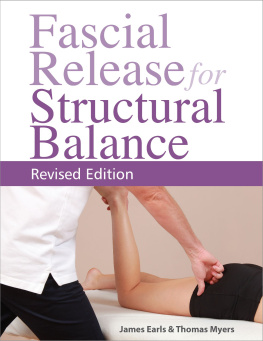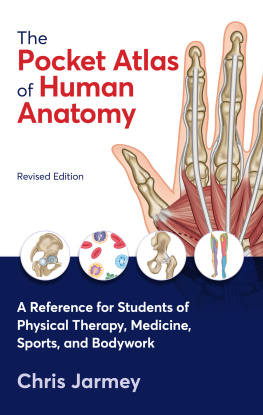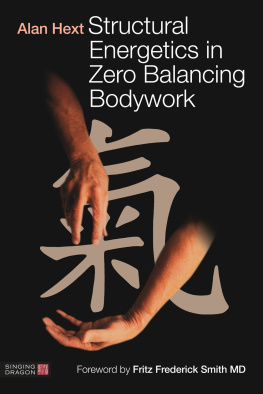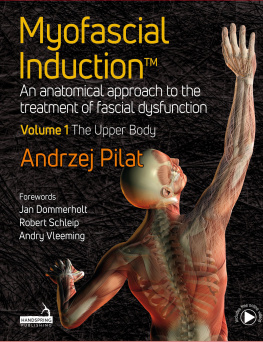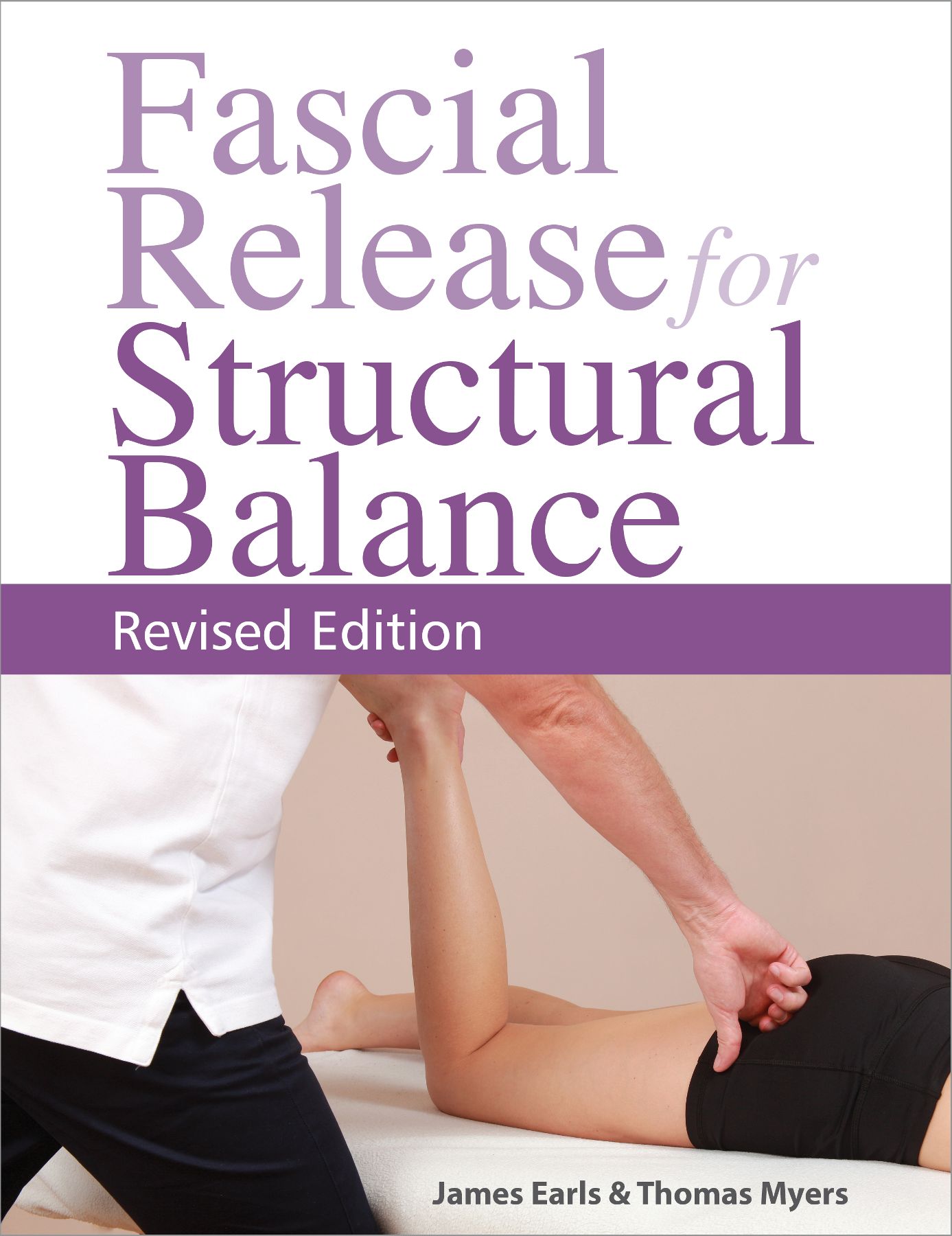Fascial Release for Structural Balance
Revised Edition
James Earls & Thomas Myers

Chichester, England

North Atlantic Books
Berkeley, California
Copyright 2010, 2017 by James Earls & Thomas Myers. All rights reserved. No portion of this book, except for brief review, may be reproduced, stored in a retrieval system, or transmitted in any form or by any meanselectronic, mechanical, photocopying, recording, or otherwisewithout the written permission of the publisher. For information, contact Lotus Publishing or North Atlantic Books.
First published in 2010. This revised edition published in 2017 by
Lotus Publishing
Apple Tree Cottage, Inlands Road, Nutbourne, Chichester, PO18 8RJ and
North Atlantic Books
Berkeley, California
Anatomical Drawings Amanda Williams, Emily Evans
Text and Cover Design Wendy Craig
Printed and Bound in the UK by Bell & Bain Limited
Fascial Release for Structural Balance is sponsored and published by the Society for the Study of Native Arts and Sciences (dba North Atlantic Books), an educational nonprofit based in Berkeley, California, that collaborates with partners to develop cross-cultural perspectives, nurture holistic views of art, science, the humanities, and healing, and seed personal and global transformation by publishing work on the relationship of body, spirit, and nature.
North Atlantic Books publications are available through most bookstores. For further information, visit our website at www.northatlanticbooks.com or call 800-733-3000.
Disclaimer
Every effort has been made to include the most accurate and up-to-date information in this publication. However, the authors would be grateful for any errors to be brought to their attention. Neither the authors nor the publishers can take responsibility for misuse of this information or for injury caused by inappropriately applied treatment. Please consult a healthcare professional before applying any of the methods discussed in this text.
The Publisher has made every effort to trace holders of copyright in original material and to seek permission for its use in Fascial Release for Structural Balance. Should this have proved impossible, copyright holders are asked to contact the Publisher so that suitable acknowledgment can be made at the first opportunity.
In memory of Stephen Stevenson, a friend, a colleague.
With my sincere thanks to his family for permission to use his images within this book.
British Library Cataloguing-in-Publication Data
A CIP record for this book is available from the British Library
ISBN 978 1 905367 76 4 (Lotus Publishing)
ISBN 978 1 62317 100 1 (North Atlantic Books)
The Library of Congress has catalogued the first edition as follows:
Earls, James.
Fascial release for structural balance / James Earls and Tom Myers.
p. ; cm.
Includes .
Summary: Fascial release for structural balance is a fully illustrated introductory guide to structural anatomy and fascial release therapyProvided by publisher.
ISBN 978-1-905367-18-4 (Lotus Pub.)ISBN 978-1-55643-937-7 (North Atlantic Books)
1. Manipulation (Therapeutics) 2. Myofascial pain syndromes. 3. Fasciae (Anatomy) I. Myers, Thomas W., LMT. II. Title.
[DNLM: 1. Fasciaanatomy & histology. 2. Massagemethods. 3. Musculoskeletal Manipulationsmethods. WE 500 E12f 2010]
RM724.E17 2010
615.82dc22
2010014999
Contents
Each persons structural pattern is uniquean expression of the many variables that combine to create the shape in each of us. Thus any analysis of structure is necessarily limited. Whether by conscious or unconscious choice, by inherited design or learnt habit, through physical or psychological trauma, we shape our body, and therefore the tissue that supports it, into one of the seven billion possibilities that is you or your client. To cover each and every one of the possible vagaries of shape would require a tome many times larger than this one.
In this book we have therefore guided you to see many of the common tendencies, with visual examples where possible. Each chapter gives you an introduction to the structural anatomy of a portion of the body, followed by hints and ideas on what to look for when analyzing clients, rounded off with strategies and tools to address the fascial sheets and guy ropes within it.
Due to the holistic nature of human patterning, it is difficult to give a linear and methodical analysis of each and every possibility, and it would bore the reader to do so. Where the logic behind a technique was not clearly covered within the anatomical or BodyReading introduction, we have given structural examples alongside the technique.
In some cases only one example is given, as it would again tire the reader to be constantly reminded that if the opposite pattern is present then the tissue relationship will be reversed. A simple understanding of the antagonistic relationship of muscles is presumed. Although this book can stand alone, many of the techniques presented here draw on the Anatomy Trains theory set forth in Anatomy Trains: Myofascial Meridians for Manual and Movement Therapists (Myers 2014), and we have not repeated all of the detail of each myofascial meridian. That information is readily available in other sources should you wish to research it further, though a summary of each is given in , for easy reference. Nevertheless, readers unfamiliar with Anatomy Trains will still find in this manual many of the necessary tools and much of the understanding needed to start making changes with their clients posture and movement.
The techniques are presented regionally rather than according to the Anatomy Trains map; though where the target area does belong within the territory of a Train it is referenced for your convenience. This allows the practitioner to take advantage of the fascial continuities by extending the release of one area by working on adjacent elements of the same line. So, for example, if the hamstrings are reluctant to release or lengthen, try following the Superficial Back Line, of which they are a significant element. We may achieve further release by working with the gastrocnemius or sacrotuberous ligamentor even the small suboccipital muscles. A key for the abbreviations of the lines is given at the end of this section.
BodyReading does take practice and we have a number of other resources to help you with it should you wish to take it further; for more details, see . Likewise, we run a number of workshops throughout the world in which we combine the Anatomy Trains theory, BodyReading, and Fascial Release Technique (FRT).
The techniques explained are not exhaustive. Certain areas have been omitted because their intimacy or their delicate nature does not lend itself to learning without the practical guidance available in a workshop or mentoring relationship. Even the techniques included could be applied in different variations. We encourage you to creatively adapt them to individuals in terms of direction, depth, and choice of your body position and applicator tool usedfingers, palm, knuckles or elbow. What is important is your understanding of what you are trying to achieve and the nature of the tissue you are working with. Much of this will depend on palpatory feedback, something that can be learnt only through practice and with a certain amount of guidance.

